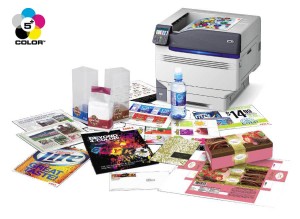Announcement posted by Comworth 22 Jul 2014
Is the cost per page of what your printer produces the only consideration that should influence the choice of machine? While that is undoubtedly one of the top factors for most businesses, it shouldn’t be the only one. Just as important are reliability, flexibility and capacities – how much paper and how many pages before the consumables have to be replaced – as these all affect convenience in the workplace.
That’s according to Paul Francois, product manager for OKI atComworth, who says the game has changed somewhat as manufacturers deliver increasingly impressive devices. “You can’t really buy a ‘bad’ printer today. Instead, your choice comes down to which is best for your business,” he notes.
In days gone by, the battle lines between the inkjet on the one hand and the laser on the other were quite simple: inkjets delivered photo colour well, but the ink cost a lot – inkjets were largely confined to home use. Lasers or LED printers, on the other hand, were typically designed for business and did black and white best at a far lower cost per page.
But today’s colour LED lasers deliver photorealistic images, formerly the preserve of the inkjet, while the latter have also raised their game in terms of cost per page.
So, what does Francois mean then, by reliability, flexibility and capacity (and he says it is in these stakes that the laser is still streets ahead)?
Reliability is the likelihood of the device to keep working; no paper jams, no blocked ink cartridges, no ‘cleaning’ or ‘printer head alignment’ cycles. “This is where not all printers are created equal. Those that use LEDs, common across OKI’s range, never have these issues because of two things: the way the image is created, and the way it is transferred to the paper.”
There are no tiny nozzles, no ink to block them, and – importantly – the paper passes straight through the device, which means very little chance of a paper jam.
There’s one other indication of reliability: The warranty. “When a manufacturer issues a three year warranty, you can be pretty sure the device is unlikely to fail any time soon,” he notes.
What about flexibility? “Printers need to do a lot more today. They need to print on card stock, transfers, A3 and A4 and A5. In businesses where creativity is required – be that a restaurant or a graphic design house – the printer has to be able to deliver a variety of formats, with vibrant colour, on one side or both. “That’s reflected in OKI’s introduction of what it calls a ‘Multimedia Production Platform – printers that don’t just print single sided A4, but devices which are capable of meeting a variety of print requirements and, in many cases, giving creative businesses the ability to do their printing in-house rather than sending it to a litho printer,” Francois explains.
Capacity refers both to the amount of paper that can be loaded, the number of pages it is designed to print per month (the duty cycle) and the quantity of prints you’re likely to make before replacing the consumables cartridge (yield). Why are these factors important? “Any interruption to your device means an interruption to business. If you’re filling it with paper every day, or if you have to unexpectedly find a replacement ink cartridge, you’re not working,” Francois notes.
He points to the OKI C900 series as an example of the yield of a modern colour laser. “These devices will deliver up to 38 000 pages before you have to replace the toner and have a duty cycle of 25000 pages per month. Business inkjet devices will struggle to match that.”
There are other advantages, too: LED has lower power consumption and gets more pages from a toner cartridge than an inkjet typically delivers. That means reduced business interruption and a better bottom line.
Finally, what about pure ‘speed’ of pages printed? Francois says this, along with image quality, isn’t much of an issue any longer. “Even entry-level devices are printing 30 to 50 pages per minute. And if the image quality isn’t photo-realistic, the printer’s not in the game.”
OKI. Clever Printers.
Media Contacts
Marketing Coordinator



